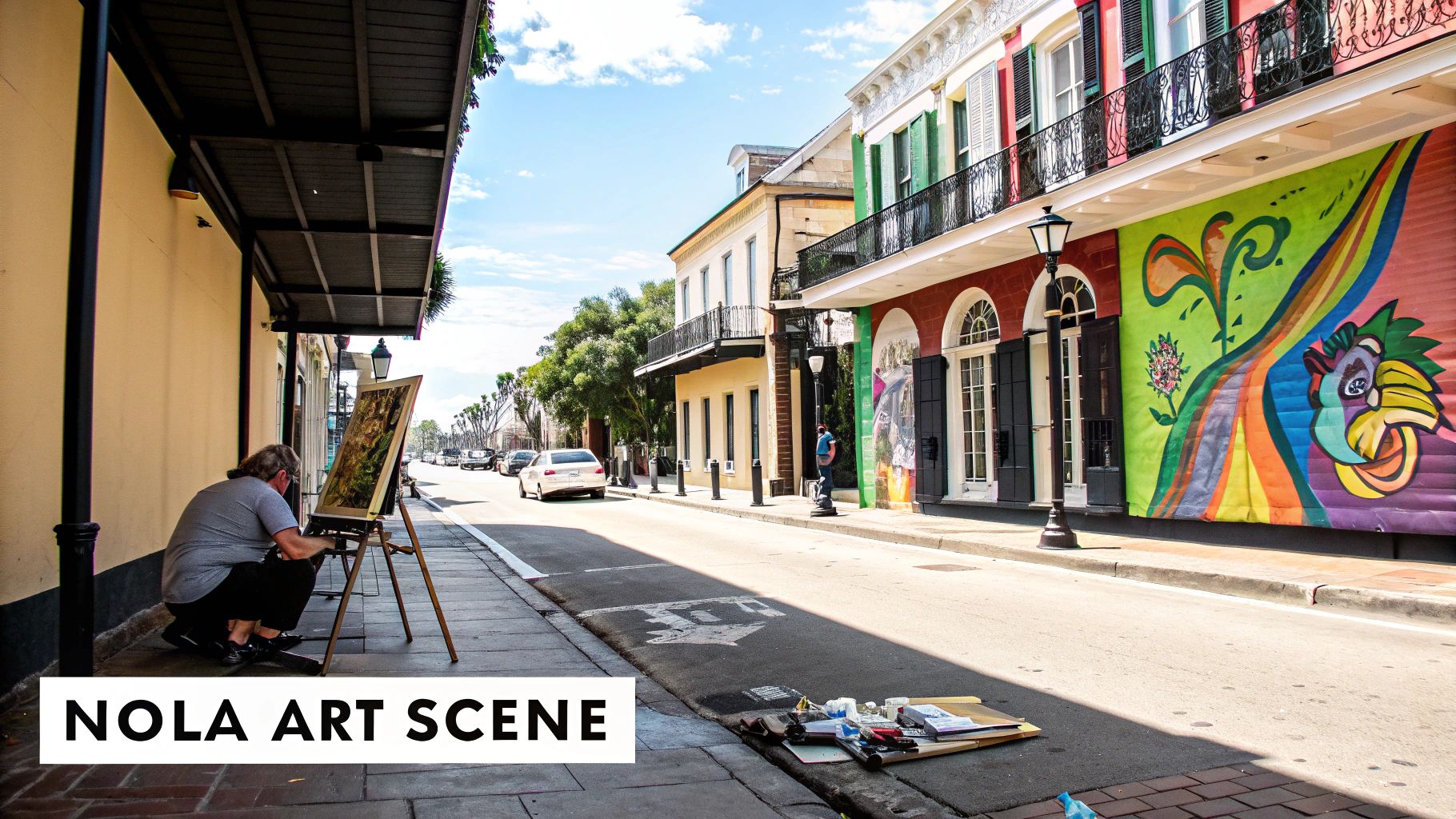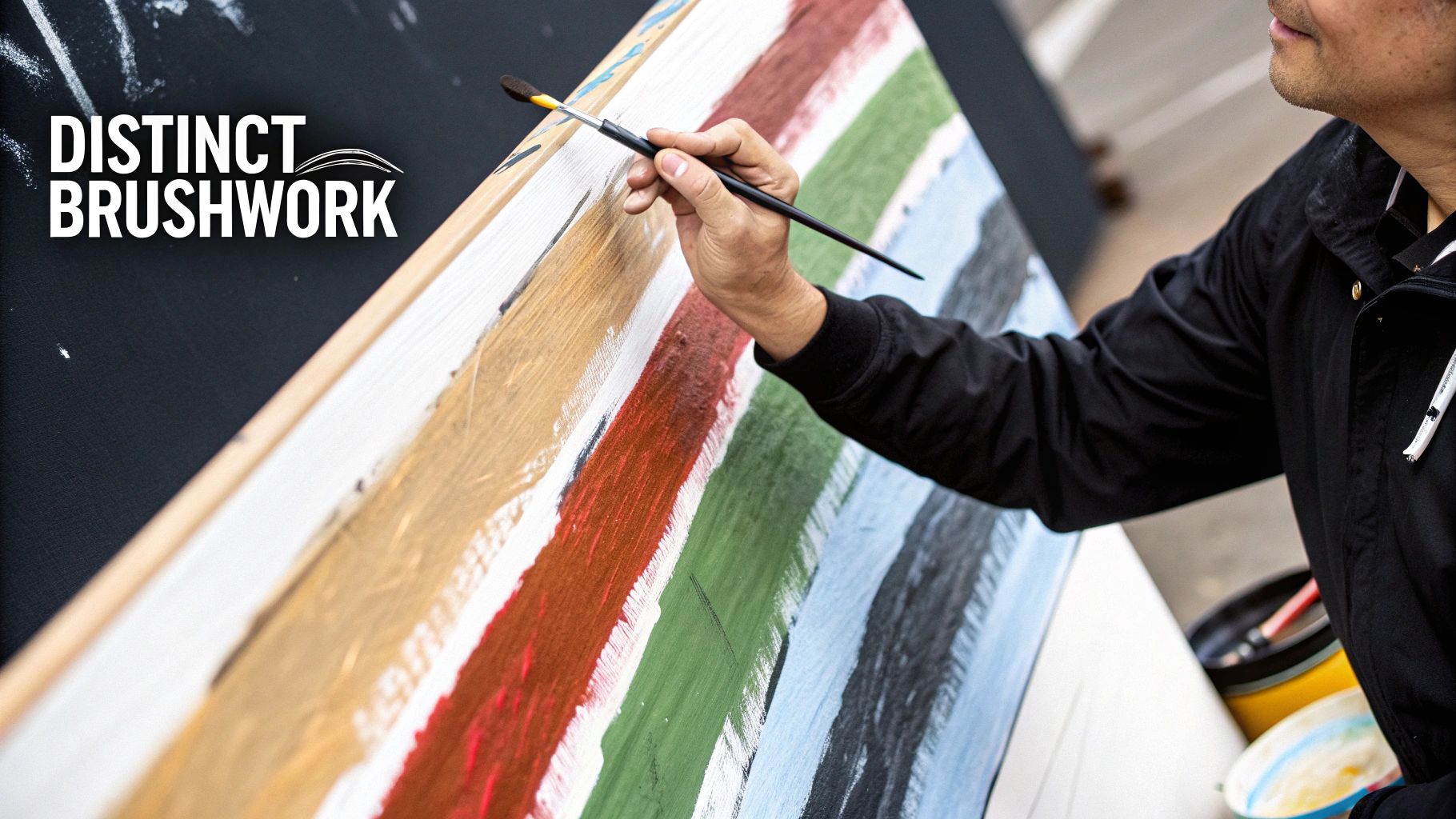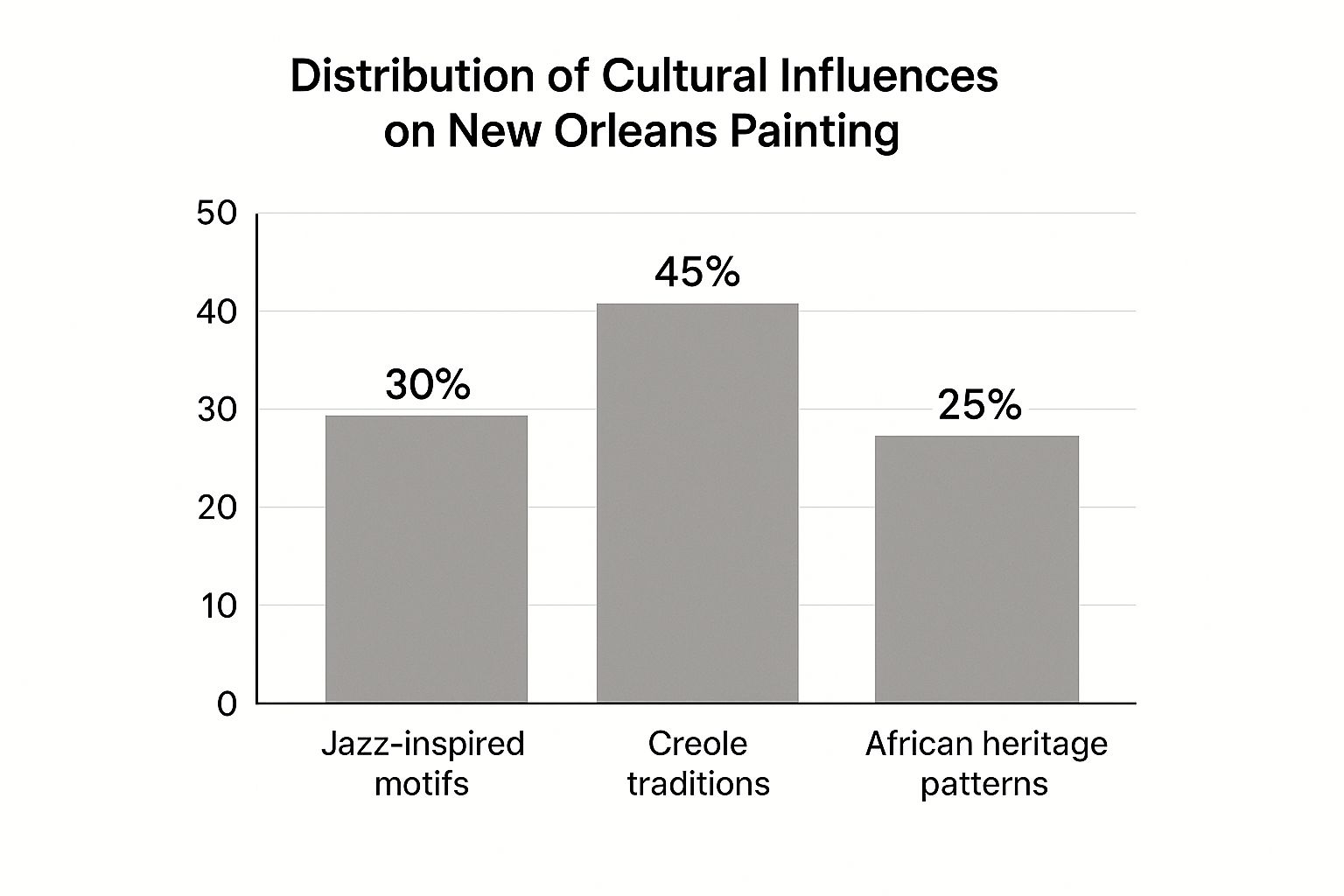If you've ever searched for a "New Orleans artist painter," you know the city is brimming with a kind of creative energy you can't find anywhere else. It’s a place where art and soul are one and the same. In this vibrant scene, William Tucker has carved out a special niche, becoming a powerful contemporary voice for Louisiana's untamed spirit.
His paintings aren't just pictures; they're a love letter to the wild heart of the bayou, brought to life with every dynamic brushstroke.
The Soul of a New Orleans Artist Painter

To understand William Tucker's work is to understand he's more than just a painter—he's a storyteller and a fierce conservationist at his core. His art is like opening a window and feeling the humid air of the swamp on your skin. It bridges the timeless beauty of Louisiana's wildlife with an urgent call to protect it for the generations to come.
This commitment to capturing the essence of the region is part of a long, proud tradition. Between the late 18th and mid-19th centuries, New Orleans was home to a remarkable lineage of painters who shaped the city's cultural identity. Artists like Ferdinand Latizar, celebrated for his portraits of prominent citizens, helped put New Orleans on the map as a serious artistic hub. You can dive deeper into this fascinating history of early painters right here in the city.
Tucker carries that legacy forward but turns his focus toward the natural world that has always surrounded and sustained the Crescent City. When you look at his art, you're really seeing a few things come together:
- A deep connection to wildlife: Each painting feels personal. He somehow captures the unique character of every animal, whether it’s the quiet dignity of a heron or the ancient mystery of an alligator.
- A mission-driven purpose: This isn't just art for art's sake. His work is completely intertwined with his conservation efforts, giving a voice to Louisiana's fragile and beautiful ecosystems.
- A unique artistic voice: He has this incredible ability to translate the very atmosphere of the swamps—the light, the color, the mood—onto canvas, creating a style that is immediately recognizable and entirely his own.
Getting to know Tucker’s portfolio is a fantastic way to connect with the many talented artists in New Orleans who are actively shaping the city’s creative future.
From Sketchpad to Swampland: An Artist's Journey
Every great artist has an origin story, and for New Orleans painter William Tucker, his is woven right into the fabric of Louisiana’s wild landscapes. Long before he ever picked up a professional brush, his artistic eye was being shaped by the world just outside his door. His journey didn't start in some sterile studio; it began in the humid, teeming life of the bayou.
As a kid, his explorations were more about observation than just play. He spent countless hours learning the subtle language of the swamp—how a ripple in the water could signal something moving beneath, or the specific call of a distant shorebird. These early days weren't just about making memories; they were the first, foundational sketches for a lifelong passion.
Forging an Artistic Voice
As his raw talent started to blossom, Tucker knew he needed to refine his skills with formal training. He sought out mentors, learning from established artists who knew how to channel the untamed energy of the natural world onto a canvas. He mastered the technical side of painting—composition, color theory, and brushwork—but his real education always came from the swampland itself.
You can see this dual education in his style. The structure and discipline he learned provide the framework, but the wild, unpredictable soul of the Louisiana wetlands gives his work its heart. It’s a perfect blend of technique and intuition.
This formative period was about more than just learning how to paint; it was about learning how to see. Tucker developed an incredible eye for catching those fleeting moments most of us miss: the iridescent sheen on a duck's feathers, the intense, focused gaze of a predator, or the way golden light filters through a stand of cypress trees. It’s these tiny, authentic details that make his work feel so alive.
Tucker’s transition from a young kid inspired by his home to a dedicated wildlife painter wasn't some overnight thing. It was a slow, deliberate evolution. With every sketch, every painting, and every walk through the marsh, his purpose became clearer. He realized that being a New Orleans artist painter came with a kind of responsibility—not just to capture the beauty of his home, but to fight for its preservation. His journey from the sketchpad to the swampland was complete, setting the stage for a career defined by both artistry and advocacy.
Capturing Life with Light and Color

What is it about a William Tucker painting that makes it feel so incredibly alive? It’s more than just a realistic depiction of an animal; it’s his uncanny ability to bottle the very atmosphere of Louisiana and pour it onto the canvas. His style is this wonderful marriage of realism and raw, expressive energy, where light and color truly do all the talking.
He wields light almost like a physical tool, using it to convey the thick, humid air of the bayou. It’s not just about what’s lit and what’s in shadow; his light has weight and texture. The way sunlight dapples through cypress leaves or glints off the murky surface of a swamp is never an afterthought. You can practically feel the heat and humidity radiating from the canvas because of how he intentionally places every ray of light.
Interestingly, this focus on light is part of a long artistic tradition in New Orleans. Centuries ago, artists like José Francisco Xavier de Salazar y Mendoza—a pivotal painter during the Spanish colonial era—used light to capture the essence of his subjects, who were mostly the city's elite. Tucker, while painting wildlife, is really carrying on this legacy of using light to reveal character. You can actually explore more about Salazar's historical portraits and see how deep these roots run in the city's art scene.
A Palette Born from the Bayou
Tucker’s color choices feel like they’ve been pulled directly from the Louisiana landscape. Forget simple greens and browns; he works with a complex spectrum of rich, earthy tones and surprisingly subtle hues. He finds the deep ochres in muddy riverbanks, the soft lavenders in a twilight sky, and the brilliant flashes of cobalt on a bird’s wing.
His approach is almost like a conversation with the environment. He isn’t imposing colors on a scene but rather listening to the ones that are already there, amplifying them to tell a more powerful story.
Brushwork That Breathes
The final piece of the puzzle is his dynamic brushwork. If you get a chance to see one of his paintings up close, you’ll notice that the texture of the paint itself is a crucial part of the artwork. The feathers of a heron aren't just painted on; they're built with energetic, confident strokes that imply movement and vitality.
- Layering: Much like the slow, deliberate buildup of sediment on Mississippi riverbeds, Tucker layers his paint to create a sense of depth and history within each piece.
- Energy: There’s nothing static about his brushwork. It gives his subjects a sense of immediacy, as if they could take flight right off the canvas.
This powerful combination of light, color, and texture is what makes him such a compelling New Orleans artist painter. He doesn’t just show you the bayou; he makes you feel it.
Painting With Purpose: A Conservation Mission
For William Tucker, a painting isn't just a beautiful object to hang on a wall. It's a statement. It’s a tool for change. His work is fueled by a powerful commitment to wildlife conservation, turning every single brushstroke into a quiet call to action.
This mission is the real "why" behind his art, framing him not just as a skilled painter from New Orleans, but as a dedicated advocate for the wild places he brings to life on canvas.
Art That Makes an Impact
Tucker puts his money where his heart is. A portion of every single sale goes directly to local environmental groups working on the front lines to protect Louisiana's incredibly fragile habitats. This isn't some vague promise; it's baked right into his business. When you buy one of his pieces, you’re not just a collector—you become an active partner in this vital work.

The funds raised through his art support a whole range of critical projects that make a real, measurable difference in our local ecosystem. We're talking about efforts like:
- Wetland Restoration: Helping replant the native marsh grasses that are absolutely essential for holding our coastline together.
- Endangered Species Protection: Funding programs that monitor and protect at-risk animals, like the precious Kemp's ridley sea turtle.
- Habitat Preservation: Assisting in securing land to prevent overdevelopment and keep natural corridors open for wildlife.
Tucker has built strong relationships with several key organizations that are doing incredible work on the ground here in Louisiana.
William Tucker's Conservation Partnerships
| Organization Name | Primary Mission | Example Project Funded |
|---|---|---|
| Coalition to Restore Coastal Louisiana (CRCL) | Restoring and protecting Louisiana's coastal ecosystems through hands-on projects and advocacy. | Oyster shell recycling programs to build new, living shorelines. |
| Audubon Nature Institute | Inspiring a deep appreciation for nature and wildlife through education, conservation, and research. | Supporting the Gulf United for Lasting Fisheries (G.U.L.F.) program. |
| The Nature Conservancy in Louisiana | Protecting ecologically important lands and waters for nature and people. | Land acquisition efforts to preserve critical migratory bird habitats. |
By aligning with these groups, Tucker ensures that the inspiration he draws from Louisiana’s environment is given back in a way that helps it thrive for generations to come.
The unique cultural identity of New Orleans art has always been tied to its environment. By channeling his passion into conservation, Tucker adds another powerful layer to this story, helping to ensure the natural world that inspires so much creativity continues to flourish. You can learn more by exploring the captivating world of wildlife art and its growing role in advocacy.
A Virtual Gallery of Louisiana Wildlife

Diving into William Tucker’s portfolio feels like a personal tour through the Louisiana wetlands. You're not just looking at pictures; you're stepping into a specific moment he experienced, a story he decided to tell on canvas.
Let’s pull back the curtain on a few of his most significant pieces. You’ll see exactly how a real-world encounter—the emotions, the challenges, the sheer awe of it—transforms into a finished work of art. It’s where his unique style and conservation mission truly become one.
The Story of 'Egret at Dawn'
One of Tucker's most beloved paintings, Egret at Dawn, is the definition of quiet majesty. It freezes a great egret in the first blush of morning light, and the story behind it is just as serene. The inspiration struck during a solo kayaking trip in the Barataria Preserve, where he describes the world as being perfectly still, the water like a mirror.
Suddenly, this single bird emerged from the mist. He didn't grab his camera; he reached for his sketchpad and just watched for nearly an hour. The real challenge, he said, was painting the feeling of that moment—that profound sense of peace and of being the only two creatures awake in the entire world. That’s why the light is so soft and the background so minimal; he wants your entire focus to land on the egret's elegant form.
This piece is pure Tucker. It's a simple, quiet scene that speaks volumes about the incredible beauty right in our backyards—and gives us a powerful reason to protect it. It’s this intimate connection that truly defines him as a New Orleans artist painter.
The Encounter Behind 'Alligator's Gaze'
Then you have Alligator's Gaze, a painting that swaps serenity for raw, ancient power. This piece came from a far more heart-pounding experience near Honey Island Swamp. While sketching cypress trees, Tucker got that primal feeling of being watched. He looked up to find an old, battle-scarred alligator half-submerged just feet away, its eyes locked on him with a startling intelligence.
He didn't feel fear, but a deep, instinctual respect. The painting’s intensity comes from its tight focus, zooming in on the alligator's head and those hypnotic, knowing eyes. The paint is thick and textured, almost sculpted, so you can practically feel the reptile's tough, rugged hide.
Tucker’s focus on Louisiana wildlife also carves out a unique space in the city's art history, which has traditionally centered on human portraits. A recent census by the Historic New Orleans Collection revealed that 85% of their portraits were by known artists, with most being white and male. You can explore more from this fascinating portrait census, which highlights how contemporary artists like Tucker are expanding our very definition of New Orleans art.
Here’s the rewritten section, designed to sound completely human-written and natural.
How to See and Purchase William Tucker's Work
So, you're captivated by William Tucker's art and want to bring a piece of that wild Louisiana spirit into your own home? Good news—it's easy to connect with his work, whether you want to see it in person or find the perfect piece online.
You can often find his original paintings hanging in galleries around New Orleans, especially in the French Quarter and the Warehouse Arts District. The best way to know exactly where his art is currently on display is to check the "Events" page on his official website. That's your go-to source for the latest shows and exhibitions, so you don't miss an opportunity to experience the incredible texture and scale of his work up close.
Bringing a Piece Home
Ready to make one of his pieces your own? You’ve got a couple of great choices.
The most direct way to support William is by visiting his online store. There, you’ll find a curated selection of his original canvases alongside some absolutely stunning, limited-edition prints.
Every single purchase, whether it's a large original or a small print, directly funds his conservation partners. It’s a beautiful way to invest in timeless art while also protecting the future of Louisiana's wildlife.
When you're choosing, think about the space you have in mind and which animal or landscape really connects with you. Whether you go for an original or a print, you're not just buying a piece of art—you're turning your appreciation into tangible support for a mission that matters.
Got Questions for William?
It's only natural to have a few questions when you discover an artist whose work you love. Here are some of the most common things people ask about William Tucker and his art.
Can I Commission a Custom Piece?
Absolutely! William takes on a select number of custom commissions each year. If you've got an idea for a special piece, the best first step is to reach out through the contact form on his official website.
Just a heads-up: his commission slots tend to fill up fast, so it's a good idea to get in touch sooner rather than later.
Where Can I See His Art in Person?
There's nothing quite like seeing the brushstrokes and textures up close. You can often find William's paintings showcased opn the fence at Jackson Square, New Orleans.
Ready to bring a piece of Louisiana's wild spirit into your own space? You can browse all of William's original paintings and limited-edition prints over at the William Tucker Art website: https://williamtuckerart.com.
